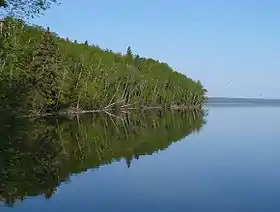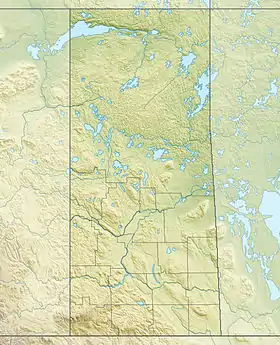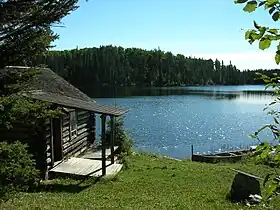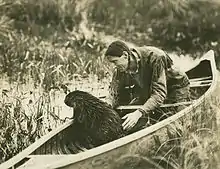Parc national de Prince Albert
Le parc national de Prince Albert est un parc national du Canada situé en Saskatchewan.

| Pays | |
|---|---|
| Province | |
| Coordonnées |
53° 57′ 00″ N, 106° 22′ 02″ O |
| Ville proche | |
| Superficie |
3 874 km2 |
| Population |
156 () |
| Partie de |
Northern Saskatchewan Administration District (en) |
| Type | |
|---|---|
| Catégorie UICN |
II |
| WDPA | |
| Création |
1927 |
| Visiteurs par an |
250 272 |
| Administration | |
| Site web |
 |
 |
Le parc compte plusieurs étendues d'eau dont les lacs Kingsmere, Crean et Waskesiu.
Faune
Le parc abrite notamment:
- une population de castors, dont des dizaines de spécimens ont été exportées pour restaurer ailleurs des populations décimées ou éteintes à cause de la chasse et du piégeage qu'elles ont subis[1] - [2].
- Une population de loups qui a fait l'objet de quelques études[3]
- Une espèce de poisson (black bass) qui y a été volontairement introduite[4]
- une population de caribous[5] et des bisons (qui ont été victimes d'anthrax[6]).
Grey Owl


C'est dans ce parc qu'a vécu une partie de sa vie Grey Owl. Ce n'est pas là que le film « Le peuple des castors » a été tourné ; film montrant Grey Owl et Anahareo, avec leurs deux castors apprivoisés, élevés après que leur mère fut tuée[7], mais Grey Owl après avoir été embauché par le « Dominion Parks Service » canadien, comme garde de parc naturel et naturaliste et installé en 1931 avec ses castors dans une cabane du parc national du Mont-Riding (Manitoba), a déménagé en 1932 dans le Parc national de Prince Albert. Il s'y est établi en tant que gardien honoraire responsable de la protection des castors[8] et il y est enterré près de sa petite maison située au bord du lac Ajawaan à moins d'un kilomètre de l'extrémité nord du lac Kingsmere.
Prospective
Les changements globaux, réchauffement climatique, perte de biodiversité, et arrivée régulière d'espèces exotiques envahissantes, associée à une fragmentation croissante des territoires et à une circulation d'espèces et de gènes ubiquistes favorisée par le commerce et les transports (routes, canaux, avions, bateaux, etc.) ont déjà des effets directs et indirects sur les biomes et donc sur les parcs qui cherchent à en préserver les spécificités[9]
Notes et références
- In 1949 the Canadian Wildlife Service introduced 50 beaver from PrinceAlbert National Park into the Peace-Athabasca delta regions in an effort to rejuvenatethe decimated populations (Law, 1949, cité par Novakowski, N. S. (1965).
- Novakowski, N. S. (1965). Population dynamics of a beaver population in northern latitudes (Doctoral dissertation)
- Banfield A (1951) Populations and movements of the Saskatchewan timber wolf (Canis lupus knightii) in Prince Albert National Park, Saskatchewan, 1947 to 1951. Department of Resources and Development, National Parks Branch, Canadian Wildlife Service.
- Rawson D.S (1945) The experimental introduction of smallmouth black bass into lakes of the Prince Albert National Park, Saskatchewan. Transactions of the American Fisheries Society, 73(1), 19-31.
- Arlt M.L & Manseau M (2011) Historical changes in caribou distribution and land cover in and around Prince Albert National Park: land management implications. Rangifer, 31(2), 17-31.
- Shury T.K, Frandsen D & O’Brodovich L (2009) Anthrax in free-ranging bison in the Prince Albert National Park area of Saskatchewan in 2008. The Canadian Veterinary Journal, 50(2), 152.
- http://www.mddep.gouv.qc.ca/parcs/lac-temiscouata/etat-connaissance/4-ressources_archeologiques_historiques.htm [archive]
- Native American Women : A Biographical Dictionary, ed. Gretchen M. Bataille & Laurie Lisa, p. 12)
- Scott D, Malcolm J.R & Lemieux C (2002). Climate change and modelled biome representation in Canada's national park system : implications for system planning and park mandates. Global Ecology and Biogeography, 11(6), 475-484.
Voir aussi
Lien externe
Bibliographie
- Blanken P.D & Black T.A (2004) The canopy conductance of a boreal aspen forest, Prince Albert National Park, Canada. Hydrological Processes, 18(9), 1561-1578.
- Carbyn L.N (1971) Description of the Festuca scabrella association in Prince Albert National Park, Saskatchewan. Canadian Field-Naturalist, 85, 25-30.
- Friedli H.R, Radke L.F, Payne N.J, McRae D.J, Lynham T.J & Blake T.W (2007) Mercury in vegetation and organic soil at an upland boreal forest site in Prince Albert National Park, Saskatchewan, Canada. Journal of Geophysical Research: Biogeosciences, 112(G1).
- Gimbarevsky P (1973) Ressources naturelles du parc national de Prince Albert. Ottawa: Institut d'aménagement forestier, Service canadien des forêts.
- Padbury G.A, Head W.K & Souster W.E (1978) Biophysical resource inventory of the Prince Albert National Park, Saskatchewan. Saskatchewan Institute of Pedology Publication S, 185.
- Saskatchewan's Playground: A History of Prince Albert National Park. Saskatoon: Fifth House, 1989.